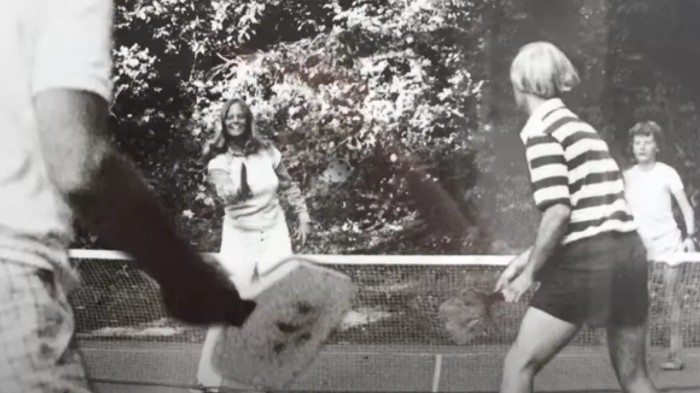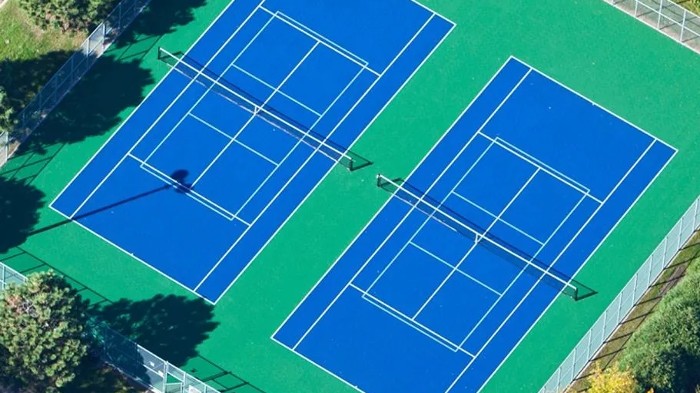Over the past few years, a relatively new sport has been gaining popularity and transforming tennis courts all around the world. Pickleball, originally invented in the mid-1960s, has experienced a resurgence, attracting players of all ages and skill levels.
In this article, we are going to give a brief introduction to pickleball and the reasons for its increase. Then, we are going to explain the factors that you must consider while converting a tennis court to a pickleball court and the impact of this conversion on tennis courts.
Introduction of Pickleball
Pickleball was created during the summer of 1965 on Bainbridge Island, Washington. Joel Pritchard, a Congressman, and Bill Bell, Pritchard’s friend, wanted to create a game that could entertain their families. They improvised a setup using a badminton court, lowered the net, and used ping pong paddles and a plastic ball. They named it after Pritchard’s dog, Pickles, who would chase the ball and then hide in bushes, mimicking the nature of the game.

Initially, pickleball was a backyard game but quickly gained popularity. By the early 1970s, dedicated pickleball courts were being built, and rules and equipment were formalized. The sport’s dynamic and inclusive nature attracted players of all ages, leading to its widespread growth.
The game is played on a court similar in size to a doubles badminton court and utilizes a paddle and a plastic ball with holes. The rules are straightforward, making it accessible to people of all ages and skill levels, which is one of the reasons for its widespread appeal.
Why There Is a Rise in the Pickleball Game?
Over the past decade, pickleball has exploded in popularity. The reasons behind this growth are multifaceted. First, pickleball is easy to learn. The rules are simple, the court is smaller than a tennis court, and the slower pace of the game makes it accessible to players of all ages and abilities. Beginners can quickly pick up the basics and start playing, providing an enjoyable playing experience.
Second, pickleball is a social sport. It can be played as singles or doubles, attracting players looking for a fun and engaging social activity. Many retirement communities, neighborhood parks, and recreational centers have embraced pickleball as a way to foster community engagement and physical fitness.
Third, pickleball is a low-impact sport that puts less stress on joints compared to tennis or other high-impact sports. This makes it appealing to older individuals or people recovering from injuries who still want to stay active. The sport’s slower pace and smaller court size also contribute to reduced physical strain.
Lastly, pickleball offers fun and fast-paced gameplay. The sport combines elements of tennis, ping pong, and badminton, creating an exciting and competitive atmosphere. With its addictive nature and engaging rallies, pickleball appeals to both casual players and serious competitors, providing something for everyone.

Factors to Consider for Converting a Tennis Court to Pickleball Court
Converting a tennis court to a pickleball court requires careful planning and consideration of several factors. First, tennis courts need to be resized to accommodate the smaller pickleball court size. The dimensions and markings must comply with official pickleball regulations to ensure fair play. This typically involves painting new lines on the court and adjusting the net height accordingly.
Another important consideration is the type of surface material used on the court. Different surfaces provide varying levels of ball bounce and slip resistance, which can affect gameplay. Ideally, the chosen surface should be suitable for both tennis and pickleball, optimizing performance for both sports.
In addition, Converting a tennis court to pickleball court might require installing additional equipment, such as portable pickleball nets, paddles, and balls. Providing separate storage or equipment sharing systems for each sport ensures easy access and minimizes disruptions during transition times.
Impact of Conversion on Tennis Courts
The surging popularity of pickleball has created a demand for dedicated pickleball courts. To meet this demand, many tennis courts have been converted or modified to accommodate both sports. Conversion involves resizing existing tennis courts, adding pickleball lines and nets, and adjusting the overall layout to suit both sports.
Converting tennis courts into shared spaces benefits both pickleball and tennis enthusiasts. Tennis courts, which are often underutilized, can now serve two different communities, maximizing their usage. By embracing pickleball, tennis clubs and facilities can attract new members, increase revenue, and provide additional programs and playing opportunities. Moreover, shared spaces allow for cross-sport interaction and camaraderie between pickleball and tennis players, fostering a sense of community and promoting diversity in sports.

The Future of Tennis Courts
The rise of pickleball has had a significant impact on the transformation of tennis courts. As the popularity of this hybrid sport continues to grow, we can expect to see more tennis courts converted to accommodate both sports. The shared use of these spaces promotes inclusivity, physical activity, and community engagement. With the increasing demand, it is essential that tennis clubs and facilities adapt to the changing landscape and embrace the opportunities pickleball brings.
Frequently Asked Questions
Pickleball is a paddle sport that combines elements of tennis, badminton, and table tennis. It is played on a smaller court with a modified tennis net and a paddle instead of a racket. Pickleball is gaining popularity due to its lower physical impact compared to tennis, making it suitable for people of all ages and athletic abilities.
The rise of pickleball has led to the conversion of tennis courts into pickleball courts. Tennis courts can be easily adapted to accommodate multiple pickleball courts, making efficient use of the existing infrastructure. This conversion enables tennis facilities to cater to the increasing demand for pickleball and attract a broader range of players.
Although pickleball courts can be created on existing tennis courts, there are some minor differences between the two. Pickleball courts are smaller, measuring 20 feet wide instead of 27 feet for singles tennis and 36 feet for doubles. Additionally, pickleball courts may have additional painted lines to mark specific areas or serve as boundaries for the game.
Converting a tennis court to pickleball court benefits various groups. First, it provides an opportunity for tennis facilities to diversify their offerings and increase revenue streams. Second, it appeals to individuals seeking a low-impact sport that is easier on the joints. Lastly, pickleball allows a wider range of age groups and skill levels to partake in an enjoyable and social paddle sport, fostering a sense of community.
Yes, in most cases, tennis courts can be easily converted back to their original state if needed. The process usually involves removing the pickleball court lines and restoring the tennis net and boundaries. This flexibility allows facilities to adapt to changing demands and use the courts for different sports or activities as required.
Conclusion
Pickleball has emerged as a highly popular sport in recent years, leading to the conversion of many tennis courts to cater to its growing fanbase. The sport’s accessibility, social nature, low-impact characteristics, and engaging gameplay have contributed to its rapid rise.
Converting a tennis court to a pickleball court not only maximizes the utilization of existing infrastructure but also provides new opportunities for tennis facilities to attract a broader audience and foster community bonds. As the trend continues, more tennis courts are expected to be transformed, solidifying pickleball’s position as a prominent sport and reinforcing the versatility of tennis courts as multi-purpose sports venues.

